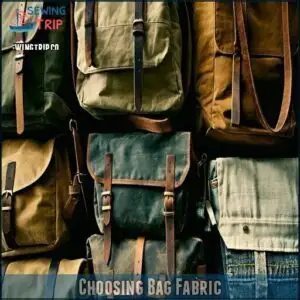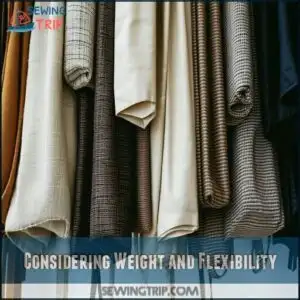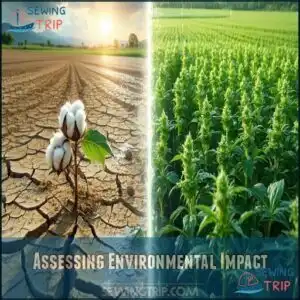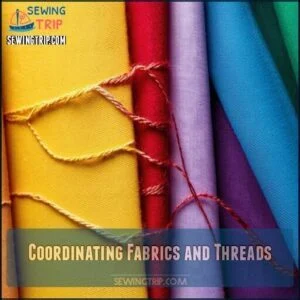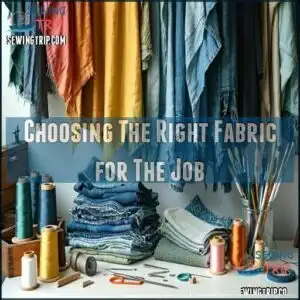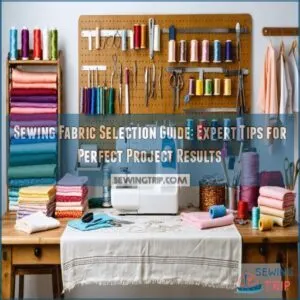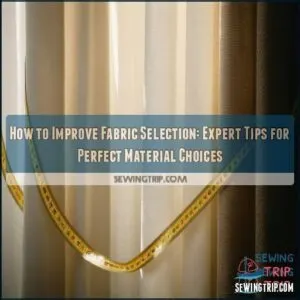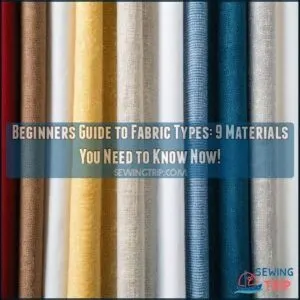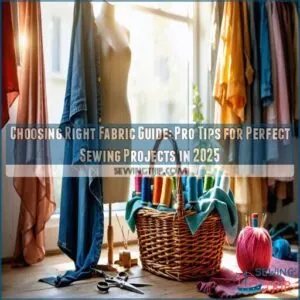This site is supported by our readers. We may earn a commission, at no cost to you, if you purchase through links.
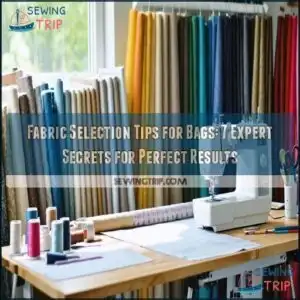
Canvas and denim offer durability for everyday totes, while leather provides structure and sophistication.
Consider fabric weight carefully—heavier materials like upholstery-grade cotton stand up to daily wear, while quilting cotton works for lighter projects.
Don’t forget interfacing to reinforce your creation.
Water-resistant options like waxed canvas or vinyl protect contents from unexpected showers.
Test fabric strength by giving it a firm tug—if it stretches easily, it’ll likely sag when carrying items.
The perfect fabric selection transforms an ordinary bag into something that’s as functional as it is fashionable.
Table Of Contents
Key Takeaways
- Match fabric to purpose: You’ll need durable materials like canvas or denim for everyday use, leather for structure and elegance, and waterproof options like waxed canvas or nylon for protecting contents from unexpected weather.
- Consider weight and flexibility: You should choose heavier fabrics like upholstery-grade cotton for bags that need to maintain their shape, while selecting lighter, more flexible materials for collapsible or packable designs.
- Don’t forget reinforcement: You’ll want to incorporate interfacing and pay attention to seam strength at stress points, especially when working with lighter fabrics that might otherwise stretch or sag when carrying items.
- Balance aesthetics with functionality: You can express your personal style through color, texture, and prints, but always ensure your fabric choice supports the bag’s intended use and maintenance requirements for long-term durability.
Choosing Bag Fabric
You’ll need to carefully consider your bag fabric’s durability, weight, and water resistance based on its intended purpose, as the right material forms the foundation of a successful project.
Whether you’re crafting an everyday tote or a specialized travel bag, selecting appropriate fabric guarantees your creation will maintain its structure and appearance through regular use, which is crucial for a bag’s overall durability.
Durability and Longevity
When selecting fabric for bags, prioritize durability and longevity to guarantee your creation withstands daily wear.
Look for high tear resistance and abrasion resistant fabric that won’t fray at stress points. Heavy duty fabrics with strong seam strength will serve you best for everyday use.
Consider colorfastness and weather resistance, especially for outdoor applications. For a wide selection, you can explore bag fabrics online.
Durable bag material might cost more initially, but fabric strength pays off through extended usability and fewer replacements.
Style and Aesthetics
Beyond mere function, your bag’s style and aesthetics speak volumes about your personal taste.
When selecting bag fabric, consider how color palettes and texture combinations create visual harmony.
Bold prints can make a statement, while subtle textures add depth.
Embellishment options like embroidery or appliqué elevate simple designs.
Remember, current print trends might catch attention today, but classic appearance choices guarantee your bag remains stylish tomorrow, and bold prints can make a statement, while subtle textures add depth.
Maintenance and Care
The visual appeal of your bag is just one part of the equation—how easy it’s to clean matters too.
Fabric maintenance can make or break your bag’s lifespan. Choose materials with known stain resistance like treated canvas or nylon for everyday use.
The right stain-resistant fabric turns a simple bag into a worry-free companion for life’s messiest adventures.
For enhanced protection, consider options with inherent stain resistance.
Check care instructions before purchasing—some fabrics require dry cleaning while others handle machine washing.
Simple storage solutions like dust bags prevent wear and tear when not in use, and following these tips can enhance the overall lifespan of your bag, making it a worthwhile investment.
Purpose and Intended Use
While caring for your bag keeps it looking fresh, the fabric you choose must first match your bag’s purpose.
Different activities demand specific fabric types. A hiking backpack requires weather-resistant materials, while a formal clutch calls for elegant options.
Consider load capacity, user demographics, and style preference when selecting materials. Gym bags need breathable, odor-resistant fabrics, while beach totes should resist sand and moisture.
Your intended use dictates everything, and choosing the right fabric is crucial for the bag’s functionality and durability.
Fabric Types and Uses
The realm of bag fabric types offers a spectrum of possibilities for your next creation.
Natural fabrics like cotton canvas deliver breathability and classic appeal, while leather bag options provide luxurious durability that ages beautifully with proper care.
You’ll find synthetic fabrics such as nylon bag material offer lightweight water resistance—perfect for everyday use in unpredictable weather.
Specialty fabrics combine functionality with unique characteristics; waterproof laminated cotton keeps contents dry during sudden downpours.
Consider fabric weight carefully—heavier materials stand up to daily wear but add bulk, while lighter options create more flexible, packable designs.
For statement pieces, luxury fabrics like silk, velvet, or premium faux leather elevate ordinary bags to conversation starters.
Remember that each material has specific strengths—canvas bag fabric excels in sturdy totes, while microfiber works wonderfully for softer, collapsible styles.
Understanding fabric GSM is essential for selecting the right material thickness for your bag project.
Budget and Cost Considerations
You’ll need to balance quality against cost when selecting fabrics for your bag-making projects, weighing durability requirements against your available budget.
Smart purchasing strategies, such as buying in bulk or exploring sustainable material alternatives, can help you achieve professional results without breaking the bank.
Cost Vs Quality Trade-offs
After exploring various fabric types, let’s tackle the tough balancing act between cost and quality. When selecting bag materials, you’ll often face cost-quality tradeoffs that impact your budget allocation.
Higher-priced fabrics typically offer better durability expectations and material lifespan, but they aren’t always necessary.
Match fabric strength to your bag’s purpose – splurge on high-quality fabrics for everyday workhorses while choosing more affordable options for seasonal or occasional pieces.
This approach maximizes long-term savings and value perception.
Sewing your own clothes requires balancing fabric and hardware costs to guarantee savings.
Bulk Purchasing and Discounts
While balancing cost and quality matters, your wallet will thank you for strategic bulk purchasing.
Smart fabric buying in larger quantities yields significant savings for your bag-making projects.
- Build supplier relationships – Regular orders often lead to preferential pricing and first access to new materials
- Master negotiation tactics – Don’t hesitate to ask about volume discounts when placing minimum orders
- Consider storage considerations – Only purchase what you can properly store and use
Sustainable Materials
The green revolution in bag-making has made sustainable materials more accessible than ever.
Sustainable bag-making isn’t just ethical—it’s now economical, accessible, and aesthetically striking.
You can now choose from recycled fabrics like rPET made from plastic bottles, organic cotton grown without synthetic pesticides, or innovative materials like Piñatex created from pineapple byproducts.
These eco-friendly fabrics also reduce your environmental footprint and often deliver excellent durability and unique aesthetics for your bag projects, making them a great choice for those looking for sustainable materials.
Sourcing and Quality Assurance
You’ll need to establish reliable fabric sources and implement thorough quality checks to guarantee your bag projects meet professional standards.
Whether you’re working with local suppliers for quicker turnaround times or exploring online marketplaces for greater variety, building strong relationships with manufacturers will ultimately lead to better pricing, consistent quality, and customization options that elevate your finished products.
Local Suppliers and Lead Times
Through local suppliers, you’ll typically enjoy shorter lead times and the invaluable opportunity to inspect materials in person before purchasing.
Building relationships with reliable suppliers in your area offers distinct advantages:
- The thrill of touching fabrics before committing to a purchase
- Peace of mind from establishing payment terms face-to-face
- Satisfaction of supporting your local economy
Supplier proximity also simplifies quality control and often allows for smaller minimum orders and customization options that overseas vendors mightn’t accommodate.
The pattern envelope offers essential fabric guidance to help with your sewing projects, providing a valuable resource for making informed decisions about fabric selection.
Online Marketplaces and Selection
Within the sphere of online marketplaces, finding quality fabric has never been easier.
Amazon, Etsy, and Alibaba offer vast selections of bag-making materials to suit every project.
When browsing these platforms, check vendor reliability and fabric authenticity before purchasing.
Don’t forget to factor in shipping costs and review return policies carefully—they can make or break your sourcing experience.
Online suppliers often provide bulk discounts that substantially reduce your material costs, which is a key factor to consider for a successful project, and it’s also important to ensure vendor reliability and fabric authenticity.
Building Manufacturer Relationships
Regularly nurturing relationships with fabric suppliers transforms your manufacturing experience.
When you establish long-term partnerships, you’ll gain access to better pricing, customization options, and priority production slots.
Communication protocols become streamlined, while quality control improves as suppliers understand your standards.
Ethical sourcing becomes easier when you’ve built trust with manufacturing facilities.
Maintain open dialogue about your needs—these connections often yield unexpected benefits when market conditions change, and this can lead to long-term partnerships and priority production.
Fabric Selection Tips
You’ll save countless hours of frustration by selecting the right fabric for your bag project before cutting your first piece.
The perfect fabric balances durability with flexibility while complementing your design vision, ensuring your finished bag performs exactly as intended, providing a perfect blend of form and function.
Considering Weight and Flexibility
Now that you’ve found reliable fabric sources, let’s talk about the physical properties that affect how your bag feels and functions.
Weight and flexibility directly impact carry comfort and how your creation behaves in daily use.
Here’s what experienced bag makers consider:
- Fabric weight (measured in GSM or ounces) determines overall bag structure
- Material drape affects how naturally the bag conforms to contents
- Packability factor matters if your bag needs to fold for storage
- Weight distribution influences comfort during extended carrying
- Reinforcement needs vary based on lightweight bag fabrics’ inherent strength
Assessing Environmental Impact
Beyond appearances, your bag’s fabric choice carries significant environmental weight.
According to 2025 data, conventional cotton fabrics require nearly 3,000 kg of freshwater per 1,000 grams compared to recycled cotton‘s mere 148 kg.
Choose eco-friendly fabrics like hemp, which absorbs more carbon dioxide than it emits during production.
For maximum impact reduction, consider recycled materials, which extend fiber lifespan while requiring 82% less CO₂e emissions than virgin materials.
Coordinating Fabrics and Threads
After considering environmental impact, let’s talk about how fabrics and threads work together to create stunning bags.
Creating visual harmony in your bag design requires thoughtful coordination of materials.
Here’s how to nail the perfect combinations:
- Match thread color to either contrast boldly or blend seamlessly with your fabric
- Consider stitch type visibility—decorative stitches deserve attention while functional ones can be subtle
- Pair textures strategically—rough with smooth creates interesting dynamics
- Confirm material compatibility between outer fabrics and bag linings
- Test fabric combinations in natural light for a truly cohesive look
To find the perfect materials, consider exploring options for specialized bag supplies, and remember that material compatibility is key to a successful design.
Choosing The Right Fabric for The Job
Now that you’ve matched your threads to your fabric palette, let’s talk about picking the right material for your specific project.
Different bag designs demand different fabric performance qualities. A beach tote needs weather resistance and high load capacity, while an evening clutch prioritizes aesthetics over ruggedness.
Consider both design complexity and stitching techniques required—some fabrics are easier to work with for beginners, while others need advanced skills to handle properly.
Beginners should consider beginner-friendly fabric options for an easier sewing experience.
Frequently Asked Questions (FAQs)
How do I choose the right fabric for my bag?
Consider your bag’s purpose first.
Match fabric to function—canvas for durability, leather for luxury, nylon for lightweight travel.
Don’t forget to factor in maintenance requirements and your personal style preferences.
How do I choose a handbag?
Choose a handbag that fits your daily needs and complements your style.
Focus on quality materials, appropriate size, comfort on your shoulder, and versatility with your wardrobe.
Don’t forget practical features like pockets.
What fabrics are best for making bags?
Like threads weaving a tapestry of style, canvas and leather shine for durability, nylon and polyester offer water resistance, while cotton provides breathability.
Your bag’s purpose should guide your fabric choice—form follows function.
What materials should be used for sewing bags?
You’ll want durable canvas or nylon for exteriors, cotton for linings, and leather or faux leather for accents.
Waterproof fabrics work well for specialty bags, while quilting cotton adds fun patterns to casual designs.
How to choose the right fabric for your project?
Match your fabric to your bag’s purpose – durable canvas for everyday use, waterproof nylon for outdoor adventures, or luxurious leather for special occasions.
Consider weight, flexibility, and maintenance requirements before committing to a specific type, as these factors can significantly impact the bag’s usability and durability.
How easy is it to make fabric bags?
Making fabric bags is relatively straightforward, especially for beginners.
You’ll need basic sewing skills, proper materials, and patience.
Most simple tote designs can be completed in under two hours with practice.
What type of fabric is best for bags?
Nearly 70% of consumers prioritize durability when choosing bag fabrics. Canvas offers strength for everyday use, while nylon provides water resistance for travel. Your bag’s purpose should guide your fabric choice.
What is the best fabric to line a purse with?
Silk, polyester, or cotton sateen fabrics will serve you best for lining purses.
They’re smooth, preventing items from snagging, and you’ll find they add a luxurious feel while protecting your belongings effectively.
What is the best material to make a bag out of?
You’ll absolutely fall in love with canvas for its unbeatable durability.
Cotton’s great for comfort, nylon offers water resistance, and leather provides timeless elegance.
Your choice ultimately depends on your bag’s intended use and style preferences.
What is the best fabric for homemade produce bags?
You’ll want lightweight, breathable cotton muslin or mesh for your produce bags.
Linen works wonderfully too, keeping vegetables fresh while being eco-friendly.
Repurposed sheer curtains offer an excellent upcycling option that’s both practical and sustainable.
Conclusion
Remember, "measure twice, cut once" applies perfectly to fabric selection tips for bags.
You’ll thank yourself for investing time in choosing materials that match your bag’s purpose, whether it’s canvas for durability or leather for elegance.
Consider weight, water resistance, and structural needs to guarantee your creation stands the test of time.
With these expert fabric selection tips for bags, you’re now equipped to create pieces that are both functional and fashionable for years to come.
- https://www.orientbag.net/post/the-top-10-bag-making-fabrics-an-expert-guide
- https://www.quora.com/How-can-you-choose-the-right-fabrics-and-materials-for-your-custom-bag
- https://littlestitchstudio.com/blog/2019/8/26/the-best-fabrics-for-bag-making
- https://jingsourcing.com/p/b10-handbag-fabrics/
- https://www.youtube.com/watch?v=gmMVzpmlOYg

